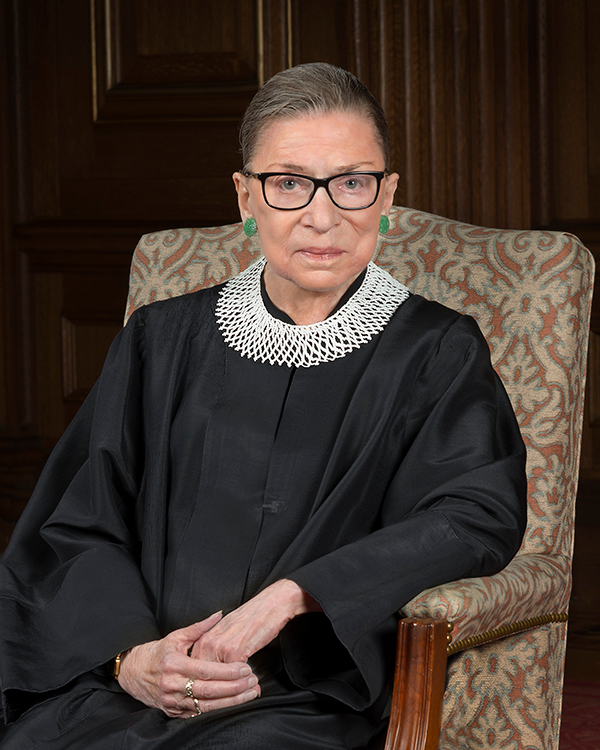Justice Ruth Bader Ginsburg dies at 87

U.S. Supreme Court Justice Ruth Bader Ginsburg.
U.S. Supreme Court Justice Ruth Bader Ginsburg died on Friday from complications from metastatic cancer of the pancreas, the Supreme Court has announced. NPR reports that she dictated to her granddaughter Clara Spera this message: "My most fervent wish is that I will not be replaced until a new president is installed."
Senate Majority Leader Mitch McConnell, R-Ky., did not acquiesce. On Friday evening, he said President Donald Trump’s nominee to replace Ginsburg will get a Senate vote, according to Politico and the Washington Post.
Ginsburg, 87, was a champion of gender equality who became a cultural icon dubbed “Notorious RBG.”
Ginsburg became the second female justice after she was appointed to the Supreme Court by President Bill Clinton in 1993. In a statement released by the Supreme Court on Friday, Chief Justice John G. Roberts Jr. called Ginsburg a “resolute champion of justice.”
“Our nation has lost a jurist of historic stature,” Roberts said. “We at the Supreme Court have lost a cherished colleague.”
Ginsburg suffered from several health issues. She revealed in July that she had been treated for liver cancer since May. She has also been treated for cancers of the lung, pancreas and colon.
Ginsburg was committed to a tough workout routine and had said she would stay on the court as long as she could do the job “full steam.” In July, she had said she was “fully able to do that.” She officiated at an outdoor wedding the last weekend of August.
The New York Times, NPR, CNN, the National Law Journal and the Washington Post have coverage of Ginsburg’s death.
Ginsburg’s husband, a tax lawyer and Georgetown Law School professor, died in 2010. She is survived by her children, Jane Carol Ginsburg and James Steven Ginsburg, and by four grandchildren.
ABA President Patricia Lee Refo expressed sympathy in a statement, calling Ginsburg “a ground-breaking jurist” and “a special friend of the ABA.”
“Ginsburg made vast and lasting contributions to the law and to the profession,” Refo said. “She was a commanding voice as an advocate for gender equality and a tenacious protector of the rule of law. She inspired generations of young lawyers in her lifetime. Although she will be greatly missed, her legacy will continue to inspire future generations of lawyers.”
Ginsburg received the ABA Thurgood Marshall Award in 1999 and the ABA Medal, the association’s highest honor, in 2010. She also was a member of the ABA Journal Board of Editors from 1972 to 1978.
She helped dedicate the ABA’s current office space in Washington, D.C., in 2013 and has a conference room there named in her honor. She has also been involved in ABA programs, including a 19th Amendment Centennial panel.
Ginsburg graduated at the top of her class at Cornell University in 1954 and married Martin that same year, according to a biography at Oyez.
She began her legal education at Harvard Law School but transferred to Columbia Law School when her husband accepted a job at a New York law firm, according to an ABA Journal profile. She was tied for first place in her class when she graduated in 1959.
Despite her class rank and a glowing recommendation from the dean of Harvard Law School, Ginsburg was turned down for a clerkship with Justice Felix Frankfurter. Instead, she obtained a clerkship with a federal judge in Manhattan.
Ginsburg became a faculty member at Rutgers Law School in 1963 and at Columbia in 1972. She also began handling gender discrimination cases for the American Civil Liberties Union.
Ginsburg was instrumental in launching the Women’s Rights Project of the American Civil Liberties Union and later was the ACLU’s general counsel and a member of its national board of directors.
“She leaves a country changed because of her life’s work,” the ACLU said in a press release after her death. The organization also announced that it will be dedicating the ACLU Center for Liberty as the Ruth Bader Ginsburg Liberty Center.
Ginsburg argued six cases before the Supreme Court from 1973 to 1978, targeting laws that gave preferential treatment to women. She won five of them, according to the New York Times obituary.
One of the cases, Weinberger v. Wiesenfeld, successfully challenged a Social Security rule that allotted child care benefits to women whose husbands died but not to men who lost their wives. The Supreme Court ruled for Ginsburg’s male client in 1975.
She was appointed to the U.S. Court of Appeals for the District of Columbia Circuit in 1980.
Three years after her appointment to the Supreme Court, Ginsburg wrote the majority opinion in United States v. Virginia, which struck down the Virginia Military Institute’s all-male admissions policy in 1996. The VMI was a state-supported military college.
“Generalizations about ‘the way women are,’ estimates of what is appropriate for most women, no longer justify denying opportunity to women whose talent and capacity place them outside the average description,” she wrote.
See also:
ABA Journal: “Justice Ruth Bader Ginsburg has become an unlikely pop culture icon”
Write a letter to the editor, share a story tip or update, or report an error.


